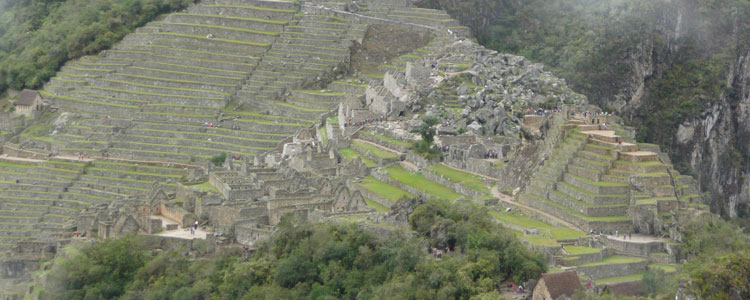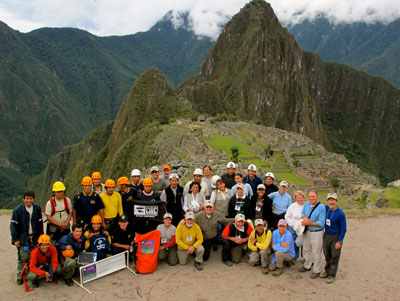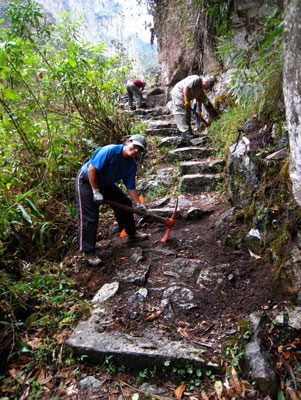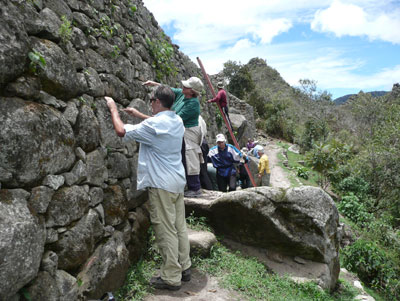Helping to preserve the incredible ruins and surroundings of Machu Picchu
by Mark Gallo, Santa Barbara, CA
Soaked by sweat and rain showers, grimy from digging drainage channels and straining to roll a big rock off a mountain trail and into the hole we had just dug, I was thinking I didn’t have to travel 4,500 miles to do this kind of work. In fact, I was among the volunteers who helped after the last wildfire in the canyons above my hometown of Santa Barbara, California.
But on this day, I was in the Andes working on an ancient Inca trail just outside of Aguas Calientes (Machupicchu Pueblo), the village below the Sacred City of Machu Picchu, with a group from Conservation Volunteers International Program (CVIP), a Santa Barbara nonprofit.
About a year before, I read about CVIP and its founder, Rich Tobin, in our local newspaper and was moved by the impact the organization was having on mitigating the wear and tear of tourism on two remarkable sites in South America. In addition to helping support them through my company, Magellan's Travel Supplies, with mentions in our national catalog mailings, I was eager to participate, so I scheduled eight days in November ’09 to take part in a shortened version of CVIP’s Machu Picchu volunteer expedition.
About the organization
CVIP’s mission is to bring small groups of volunteers to work, in two-week stints, alongside park personnel and other locals to conserve natural and cultural resources in places like Torres del Paine National Park in Chile and Machu Picchu Sanctuary in Peru.
In addition to restoring trails, volunteers at Machu Picchu work to clean the extensive stone walls and terraces of lichens, mosses and grout-crumbling weeds. The 15 volunteers who typically make up a CVIP tour group double the sanctuary’s overworked maintenance staff.
Rich’s work with the US National Park Service took him to Peru and Chile as part of the park’s exchange program in 2005. The experience introduced him to the idea of sustaining these efforts by collaborating with Peruvian cultural and environmental agencies to provide much-needed assistance, using volunteers to help maintain the fragile UNESCO World Heritage Site at Machu Picchu.
Since retiring from the Park Service and formalizing the tours under CVIP, Rich and his team have led several volunteer expeditions each year to Peru and Chile. This is the only outside volunteer group authorized by Peru’s government to work at Machu Picchu.
An incredible experience
The hikers who passed us on the trail hailed from all over the world — Australia, France, Japan, the US and, of course, Peru. Each expressed their appreciation when they saw what we were doing.
We were working on the trail that leads to the summit of Putucusi, a forested rock dome within the Machu Picchu Sanctuary that rises nearly 2,000 feet above Aguas Calientes. The summit of Putucusi overlooks the Sacred City of Machu Picchu, on the opposite side of the Urubamba River.
After completing our trail assignment for the day, I set out for the summit with our local guide, Santiago Carrasco. I was determined to get to the top despite the intermittent rain, hoping the mist and clouds would clear enough to allow me to see across the valley to Machu Picchu.
The trail was nearly vertical in places, which required us to clamor up seven different slick, wooden ladders that were nailed to the rock wall. The tallest of these led skyward to a rocky ledge 120 feet above our heads.
Much of the trail between the ladders consisted of stone steps. The effort required not technical ability but concentration to maintain my footing — it was more like climbing stairs than hiking. Luckily, it was not an especially long trail and after 40 minutes or so we were above the trees and looking out at the Urubamba River Valley in the distance.
Another 20 minutes of step climbing got us to the summit, where I got my first look at the 500-year-old ruins of Machu Picchu. I was truly staggered by the scene — and not just because I was winded!
There, on a knife-edge ridge 8,000 feet up in the Andes, lies this ancient and elaborate royal retreat of stone terraces with garden plots, watch towers, water systems, a central plaza and houses for workers, artisans and the family of the Inca ruler Pachacútec. I’d seen the photos, but seeing the stone city in person from this distance was surreal, like looking at a computer-generated special effects painting.
Doing my part
The next day we began the first of five days working within the Sacred City of Machu Picchu, painstakingly scraping lichens and moss off the building and terrace walls and pulling weeds from the mortar between stones to slow the deterioration of this magnificent edifice. Our tools were nothing more than wooden sticks and brushes. The work was tedious, but the psychological and emotional rewards made it worth it.
On a personal level, as I scraped and brushed smooth the rock, I couldn’t help thinking about the Inca hands that formed these walls half a millennium ago and the sophisticated civilization that conceived of this fantastic place, a civilization that soon unraveled in civil conflict and was overrun by the Spanish conquistadores.
On another level, I felt like we were a kind of “green Peace Corps,” doing our part to preserve this fantastic product of human achievement located halfway around the world.
In addition to the volunteer laborers, two members of the Santa Barbara County search-and-rescue team accompanied our expedition to train the park’s personnel and the local police in techniques for safely scaling the vertical terrain to recover errant hikers.
The results of the volunteers’ labors were impressive. Besides restoring 1½ miles of the lower section of the Putucusi Mountain trail, our group cleaned 4,800 square feet of stone walls and donated school supplies, medical supplies and rescue equipment.
In appreciation for our volunteer conservation and community development work, the town council of Aguas Calientes awarded Rich the “Son of the Suns” award and gave the search-and-rescue trainers the Key to the City!
A little touring
Before our first day of stone work, several of us took a couple hours and made the thrilling trek up Wayna Picchu, the prominent peak that sits in the background of Machu Picchu. The stone steps were steep and hazardous and the top was devoid of handholds, but the experience was unlike any other, as evidenced by the heavy pedestrian traffic (all ages and abilities).
After finishing our daily work assignments, and after all the other visitors had been bused back down the mountain, Santiago led us on private tours of the Sacred City. One of the advantages of visiting the Sacred City over several days was the ability to take in Machu Picchu slowly, without the distraction of tourists, allowing us to really get a sense of the place.
Our group also hiked out to see the Inca Bridge, a log bridge used by the Incas as an escape route, and hiked up to Intipunku (the Sun Gate), the high mountain entrance to Machu Picchu that marks the end of the Inca Trail from Cusco.
Due to my schedule constraints, I had to leave the group early, but I did spend some quality time touring the Inca ruins above Cusco, notably Sacsayhuamán’s zigzag stone fortification, reputedly the scene of one of the last battles between the Incas and Pizarro; Tambomachay, a ceremonial spring bath, and Pukapukara, a watchtower overlooking the Cusco Valley.
In Cusco proper, I highly recommend a visit to Qorikancha, the remnants of the gold-lined stone temples subsequently enclosed by the Santo Domingo church and convent.
The rest of the volunteers spent two additional days touring the Sacred Valley, including the famous Inca citadel above Ollantaytambo.
Planes, trains and minibuses
Getting to Machu Picchu is a long process. The good news is that Machu Picchu is in the same time zone as the US East Coast, so jet lag is minimal. To get to Aguas Calientes from Southern California, I flew American Airlines from Los Angles to Miami, then, after a layover of several hours, caught a second flight, from Miami to Lima.
From Lima our group flew LAN Airlines to Cusco, then rode in a minibus to Yucay, where we spent the night. The next day we were shuttled to the train station in Ollantaytambo for the 28-mile ride along the Urubamba River aboard PeruRail to Aguas Calientes. From there, bus shuttles take visitors up to Machu Picchu every few minutes.
I found PeruRail’s service to be very good. The railcars were clean and modern, with lots of windows for viewing the dramatic landscape.
I highly recommend the Machu Picchu Inn in Aguas Calientes for accommodations. The young staff was well trained, spoke excellent English and was eager to make our stay enjoyable. (In fact, three of the staff volunteered to help us work on the Putucusi trail one morning and returned later in the week to help us in the Sacred City.)
A quality breakfast in the café (with free WiFi) was included in our package, and my room with private bath was clean and modern.
Rich is friends with the Peruvian and French owners of Indio Feliz (Lloque Yupanqui 4; phone 011 5184 211 090, www.indiofeliz.com), a Peruvian-French fusion restaurant just around the corner from the hotel, where we were treated like returning friends. The restaurant’s chicken and salmon trout dishes received the most compliments from our group, along with the famous Pisco Sour, the quintessential beverage of Peru.
For the first night of our stay in Peru, we ate at the wonderful seafood restaurant La Rosa Nautica (Espigón 4 Circuito de Playas; phone 011 511 445 0149, www.larosanautica.com), located on a pier jutting into the Pacific in the Miraflores district of Lima.
The details
CVIP uses Latin America specialist Americas Travel (San Francisco, CA; 888/703-9955, www.americas travel.net) for all travel arrangements and bookings. In particular, our travel coordinator, Marcelo Diaz (e-mail marcelo@americas travel.net), did an outstanding job prearranging our itinerary as well as making adjustments for contingencies along the way.
The all-inclusive cost of $3,695 for the 14-day trip included international and domestic flights, ground transportation, hotels, most meals and tour guides. Considering all the logistics and the high quality of the lodging, meals and transportation services plus the training/orientation tours, the cost is a bargain. In addition, your cost may be tax deductible since CVIP is a 501(c)3 tax-exempt organization.
The seven to eight days of labor are not especially strenuous, but being surefooted is required, as there is a lot of walking up and down steps. Our group consisted of working professionals of all ages as well as retirees in their late 70s.
For more information, contact Conservation Volunteers International Program (Santa Barbara, CA; phone 805/698-6915, www.conservationvip.org).
Though efforts to clear damage from January’s mudslides continue, CVIP confirmed that all of their programs to Machu Picchu in 2010 will run as scheduled.




